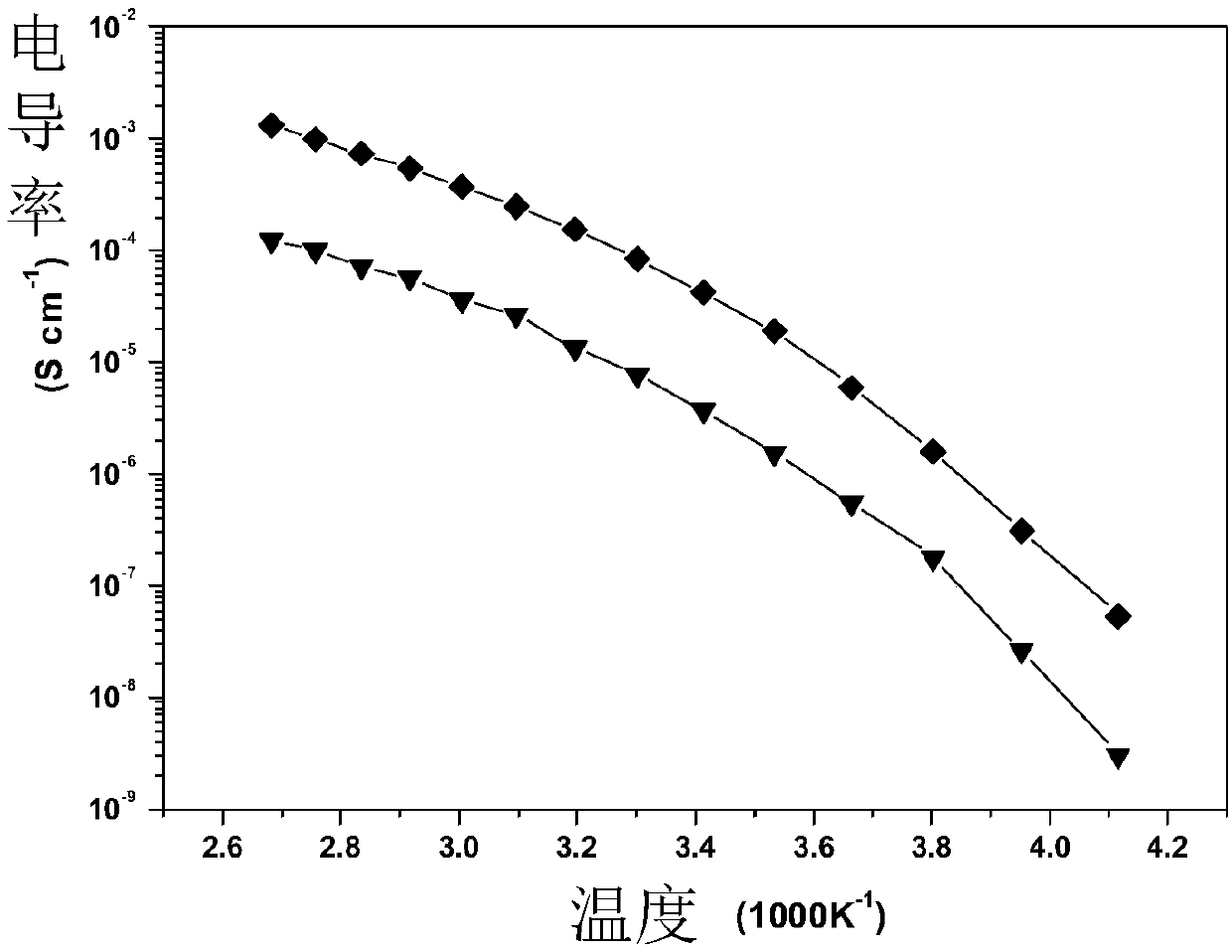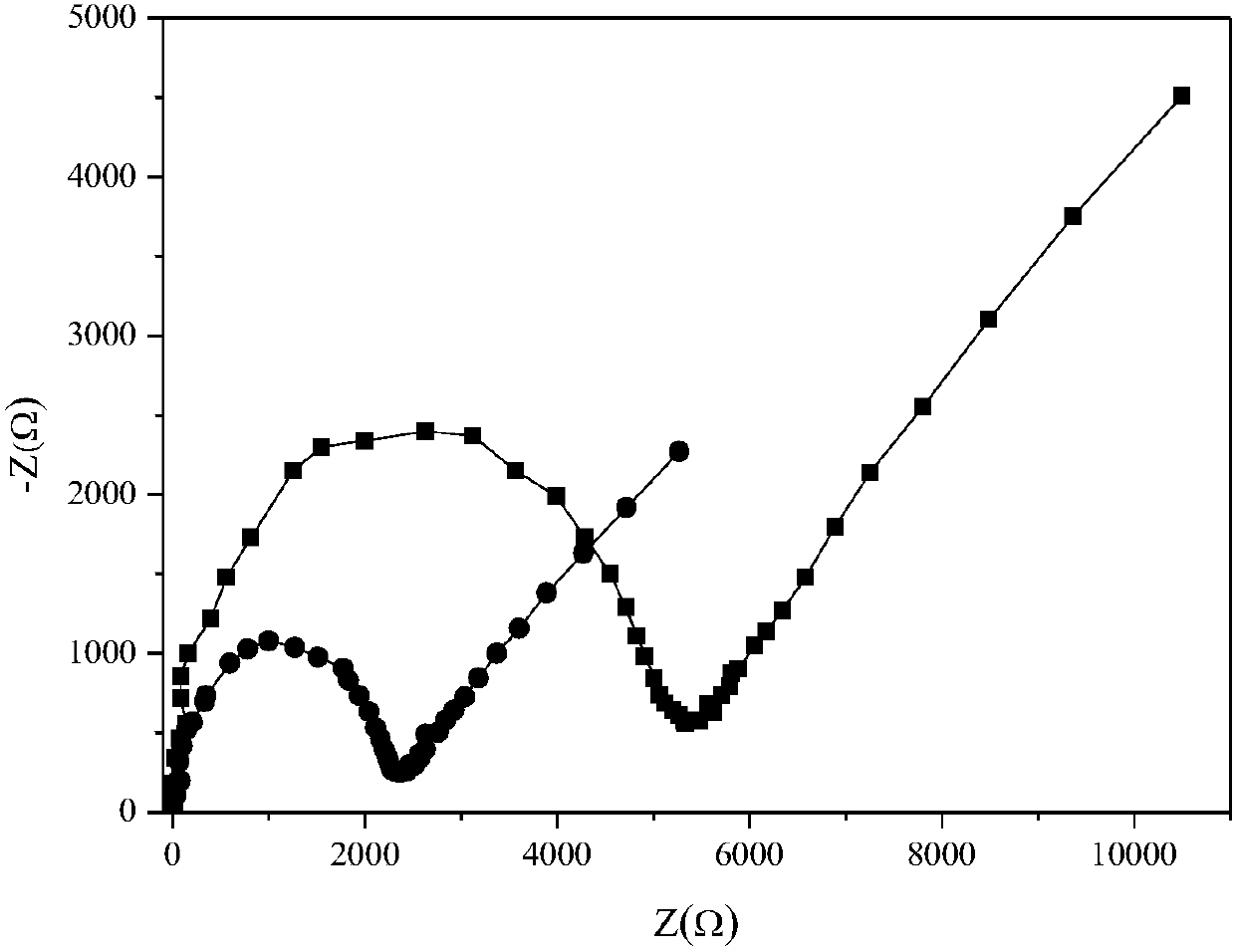Preparation method of composite polymer electrolyte
A composite polymer and electrolyte technology, applied in circuits, electrical components, secondary batteries, etc., can solve problems such as low ionic conductivity, and achieve the effects of reducing glass transition temperature, inhibiting crystallization, and enhancing low-temperature ionic conductivity
- Summary
- Abstract
- Description
- Claims
- Application Information
AI Technical Summary
Problems solved by technology
Method used
Image
Examples
Embodiment 1
[0032] An embodiment of the present invention provides a method for preparing a composite polymer electrolyte, comprising: preparing a composite polymer electrolyte by using an ion-conducting agent; the method for preparing the ion-conducting agent includes:
[0033]Accurately weigh 0.3956g of cuprous bromide and 0.9530g of pentamethyldiethylenetriamine (PMDETA) in the glove box and add them to the container. A catalyst solution was obtained. After adding 10ml of dimethylaminoethyl methacrylate (DMAEMA) and 10ml of di(ethylene glycol) methyl ether methacrylate (DEGMA) to the container, place the container in liquid nitrogen, and wait for the liquid in the container to freeze Finally, the air in the container is removed by vacuuming, and then an inert gas is introduced into the container, and the step of vacuuming and passing the inert gas is repeated 2 to 10 times, and the inert gas can be nitrogen. Add 314 μL of the first initiator methyl 2-chloropropionate (MCP) to the cont...
Embodiment 2
[0040] Accurately weigh 0.3956g cuprous bromide and 0.9530g pentamethyldiethylenetriamine (PMDETA) in the glove box and add in the container, take out the container and inject inert gas (nitrogen) after vacuumizing and deoxygenating. Under the condition, add the anhydrous first organic solvent tetrahydrofuran and fully stir and dissolve to obtain the catalyst solution. After adding 10ml of dimethylaminoethyl methacrylate (DMAEMA) and 10ml of di(ethylene glycol) methyl ether methacrylate (DEGMA) to the container, place the container in liquid nitrogen, and wait for the liquid in the container to freeze Finally, the air in the container is removed by vacuuming, and then an inert gas is introduced into the container, and the step of vacuuming and passing the inert gas is repeated 2 to 10 times, and the inert gas can be nitrogen. Add 308 μL of the first initiator 2-bromopropionate methyl ester (MBP) to the container with a microliter syringe and seal the bottle mouth. After the co...
Embodiment 3
[0045] An embodiment of the present invention provides a method for preparing a composite polymer electrolyte, comprising: preparing a composite polymer electrolyte by using an ion-conducting agent; the method for preparing the ion-conducting agent includes:
[0046] Accurately weigh 0.3956g of cuprous bromide and 0.9530g of pentamethyldiethylenetriamine (PMDETA) in the glove box and add them to the container. A catalyst solution was obtained. After adding 10ml of dimethylaminoethyl methacrylate (DMAEMA) and 10ml of di(ethylene glycol) methyl ether methacrylate (DEGMA) to the container, place the container in liquid nitrogen, and wait for the liquid in the container to freeze Finally, the air in the container is removed by vacuuming, and then an inert gas is introduced into the container, and the step of vacuuming and passing the inert gas is repeated 2 to 10 times, and the inert gas can be nitrogen. Add 366 μL of the first initiator 1-chloro-1-phenylethane (PECl) into the co...
PUM
| Property | Measurement | Unit |
|---|---|---|
| thickness | aaaaa | aaaaa |
| electrical conductivity | aaaaa | aaaaa |
| particle size | aaaaa | aaaaa |
Abstract
Description
Claims
Application Information
 Login to View More
Login to View More - R&D
- Intellectual Property
- Life Sciences
- Materials
- Tech Scout
- Unparalleled Data Quality
- Higher Quality Content
- 60% Fewer Hallucinations
Browse by: Latest US Patents, China's latest patents, Technical Efficacy Thesaurus, Application Domain, Technology Topic, Popular Technical Reports.
© 2025 PatSnap. All rights reserved.Legal|Privacy policy|Modern Slavery Act Transparency Statement|Sitemap|About US| Contact US: help@patsnap.com



